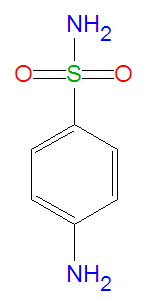Sulfanilamide
|
| |||||||
| sulfanilamide | |||||||
| |||||||
| Uses: | antibiotic drug | ||||||
| Properties: | sulfonamide | ||||||
| Hazards: | see drug interactions | ||||||
| |||||||
Sulfanilamide, often called 4-aminobenzenesulfonamide, is an antibiotic in the sulfonamide class that inhibits bacterial growth by inhibiting the production of folic acid. It competes with para-aminobenzoic acid, the natural substrate for the enzyme dihydropteroate synthetase which is essential in the folic acid cycle.
Sulfanilamide was the first clinically useful sulfonamide, no longer used due to toxicity. Gerhard Domagk, who was working on antibacterial, discovered its prototype, Prontosil, in 1935. The French researcher, Daniel Bovet, determined that only the sulfanilamide subunit of Prontosil had antibacterial.
Domagk was awarded a Nobel Prize in 1939, but the Nazi government made him refuse it.
References
The most up-to-date information about Sulfanilamide and other drugs can be found at the following sites.
- Sulfanilamide - FDA approved drug information (drug label) from DailyMed (U.S. National Library of Medicine).
- Sulfanilamide - Drug information for consumers from MedlinePlus (U.S. National Library of Medicine).
- Sulfanilamide - Detailed information from DrugBank.
